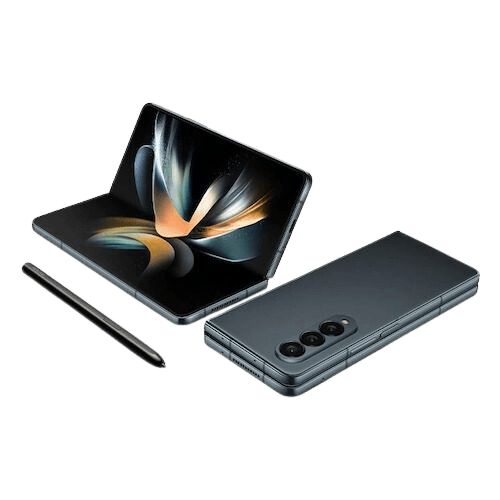Samsung Galaxy Z Fold4 review: Subtle refinement
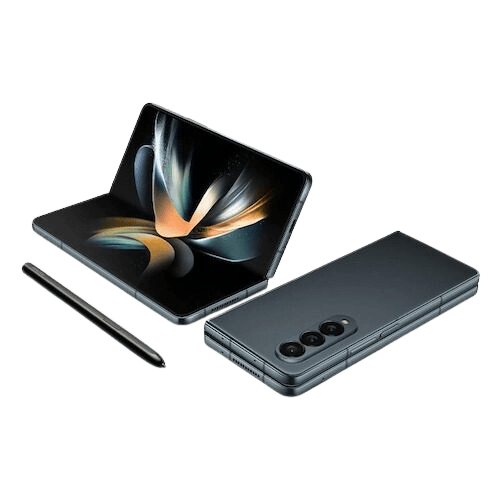
-
- Battery Score
3.5
- Camera Score
4
- Design Score
4
- Performance Score
4
- Battery Score
3.5
Summary
Quick verdict: Samsung’s fourth generation Fold is still the best foldable money can buy – but you’ll need quite a lot of money to buy one.
- Great app performance
- Taskbar enhances the tablet experience
- Improved camera works well
- Super expensive
- S22 Ultra still has better cameras
- S-Pen isn’t included, and not all S-Pens work
Details
Pricing & Availability
| RRP | $2,499 |
| Launch date | 2022-08 |
Samsung sits essentially alone in the foldable phone space. Sure, there's Motorola's RAZR line as well as an assortment of mostly Chinese-market foldable phones from the likes of Huawei, Oppo, Xiaomi and others, but trying to buy one is an interesting process.
Samsung has been selling foldable phones through regular retail outlets and telcos for 4 years now. Basically, there's Samsung, and then there are just tumbleweeds.
That puts the company in a command position, and that's both good and bad.
The Galaxy Z Fold4 is, as the name suggests, Samsung's fourth-generation foldable phone. It's clearly learned a few lessons along the way around what works and what doesn't, and as far as foldable phones go, it's the clear one to buy.
However, because Samsung doesn't really have any competition in this larger foldable space, it's also one that does rather rest on its very expensive laurels. It makes the Z Fold4 a true niche phone – a lot of fun if you can afford it, but very few will be able to meet its high asking price.
Design: Haven't I already reviewed this phone?
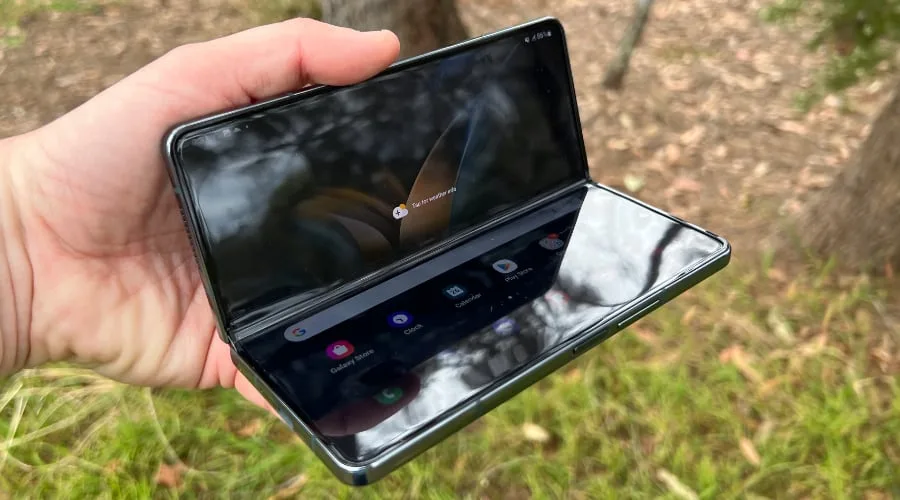
Image: Alex Kidman/Finder
Samsung made its big moves in design terms from the original Fold with the second generation Fold2 and to a lesser extent with the Fold3.
The Fold2 boosted the external screen display size up from the original model's tiny vertical slice, while the Fold3 added IPX8 water resistance and an in-display camera module.
Not surprisingly, all those moves are present in the Galaxy Fold4 as well.
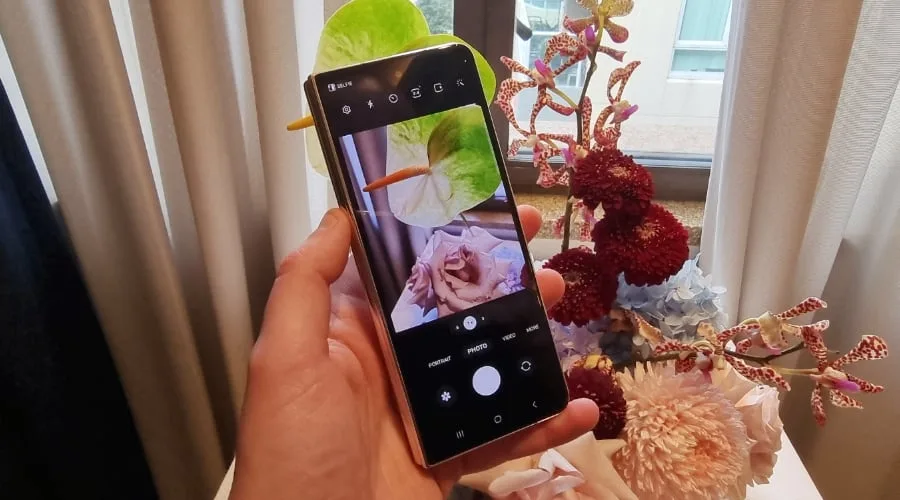
Image: Alex Kidman/Finder
The external 6.2-inch AMOLED display has a slightly wider aspect ratio than the Fold3, which is welcome, but it's one of those details you'll never notice unless you were already a Fold3 user – and even then, you'd need them side by side.
The refinements to the Fold4's design are subtle, including a slightly lighter carrying weight, which does matter more for a phone of this size than you'd think. At 263g, it's still a chunky beast to carry compared to any non-folding handset, but making it lighter is still a positive step.
In terms of colour choices, Phantom Black returns from last year, joined by graygreen, beige and burgundy.
I have no idea who chooses name colours at Samsung (or any phone maker for that matter), but does anyone think that "beige" or "graygreen" are appealing sounding colours?
The model Samsung provided me for review was the graygreen variant, and it's absolutely everything that you might think that colour would be.
I would love to see more vibrant Fold colours if anyone at Samsung's listening, but I suppose if you wanted one as a professional tool then colder tones might be just what you're looking for. The Flip4 seems to be where Samsung gets truly bold with colour choices.
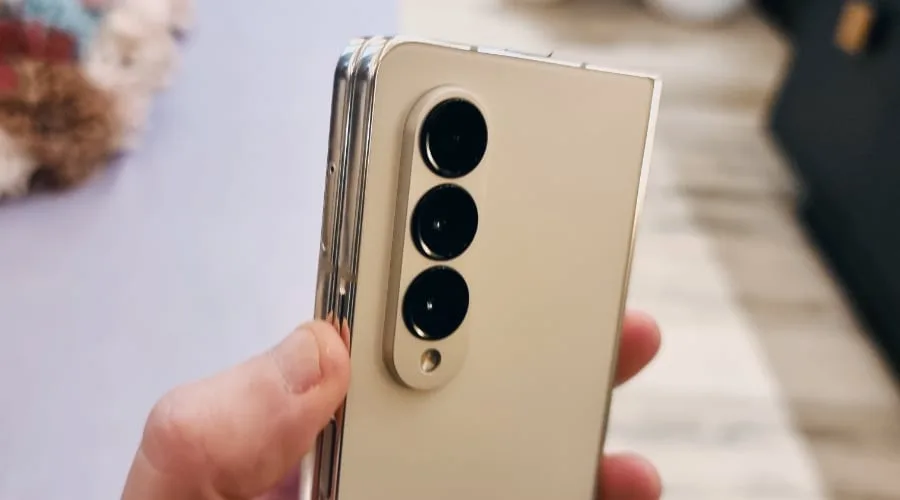
Image: Alex Kidman/Finder
At the rear, the Galaxy Z Fold4 has a bigger camera module, not just in megapixel count, but also in size. It's more or less been torn from a Galaxy S22 Plus, which means it has a slightly larger bulge than the Fold3. Not so much that you'd notice it bare in the hand, but enough that Fold3 capable cases aren't going to work with it.
Camera: It's better – but not the best
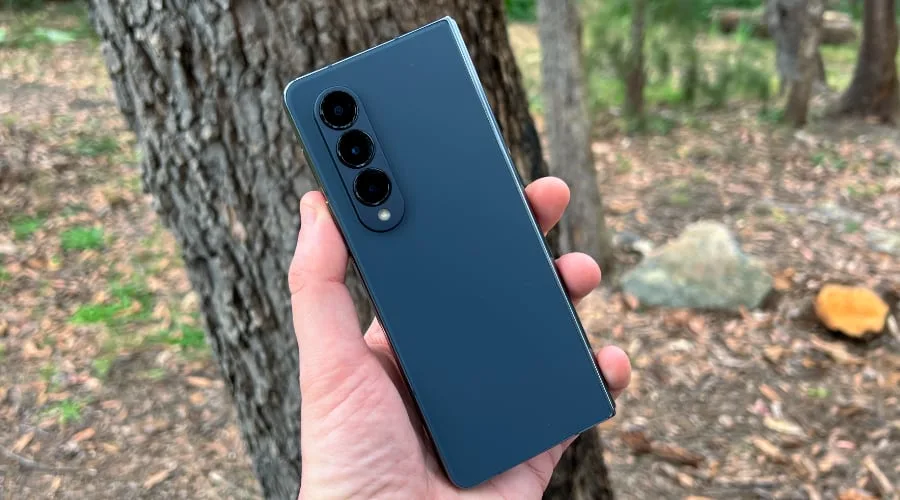
Image: Alex Kidman/Finder
The Galaxy Z Fold4 features 5 cameras in all. At the front, there's a 10MP f/2.2 camera, unchanged from last year's model. Also unchanged in specification terms from the Z Fold3 is the in-display 4MP camera that sits under the display, although Samsung has done a much better job hiding it this year.
The real action is at the back, where you'll find a trio comprising a 50MP f/1.8 wide lens, a 10MP f/2.4 3x optical zoom and a 12MP f/2.2 123' ultra-wide lens. It's a big step up from the Z Fold3, a phone that struggled against the rest of the Samsung pack last year, and even against the Galaxy S20 FE in some situations.
Testing out the Galaxy Z Fold4's cameras felt familiar, and that's because it really is basically the modules from the S22+ on a foldable phone.
The obvious comparison point here – and it's one that doesn't flatter the Z Fold4 – is that if you want the best cameras, they're to be found on the flagship Galaxy S22 Ultra. The Z Fold4 is Samsung's most expensive phone by a wide margin, but it's not the model that has the best cameras, which is weird in a value sense.
That's not to say that the Galaxy Z Fold4 has a bad camera array because it's actually very capable.
On the telephoto front, the optical zoom lens caps out at 3x, but you can push that out to up to 30x if you feel like it.
I've long felt that these extreme zooms on Samsung cameras felt invasive – like you were going to use them to peer into someone's bedroom.
With the Galaxy Z Fold4, I did just that.
Before you send over the nice constables with the truncheons, this wasn't as bad as it sounds, but it did let me test out its telephoto chops nicely.
Nearby, somebody's building a brand new house. Here's what it looks like from the road (all legal) with the ultra-wide lens (and an inadvertent thumb, which I didn't realise until well after the shot was taken):
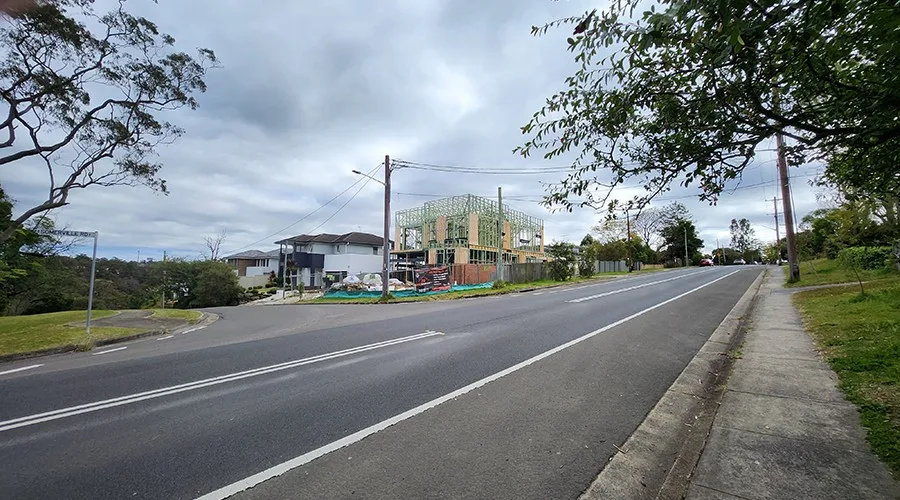
Image: Alex Kidman/Finder
The same framing with the regular wide lens, sans thumb:
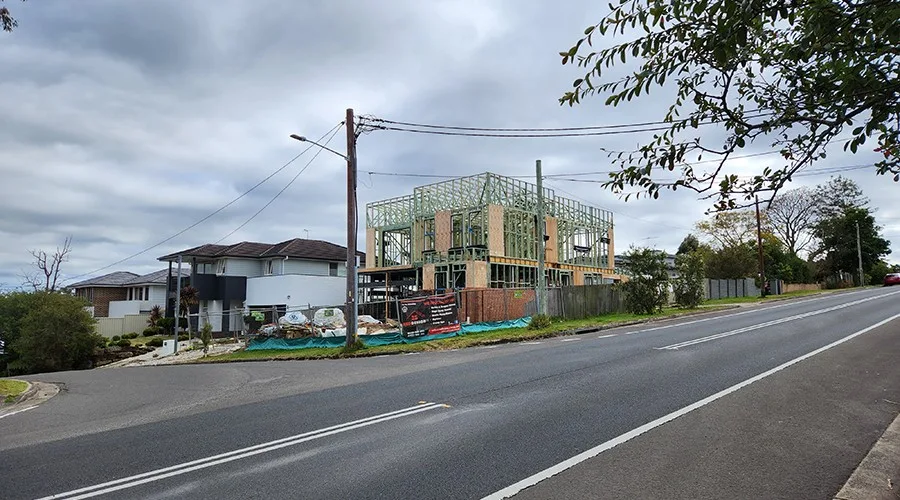
Image: Alex Kidman/Finder
At 3x zoom, it's all plain sailing, as you'd expect.
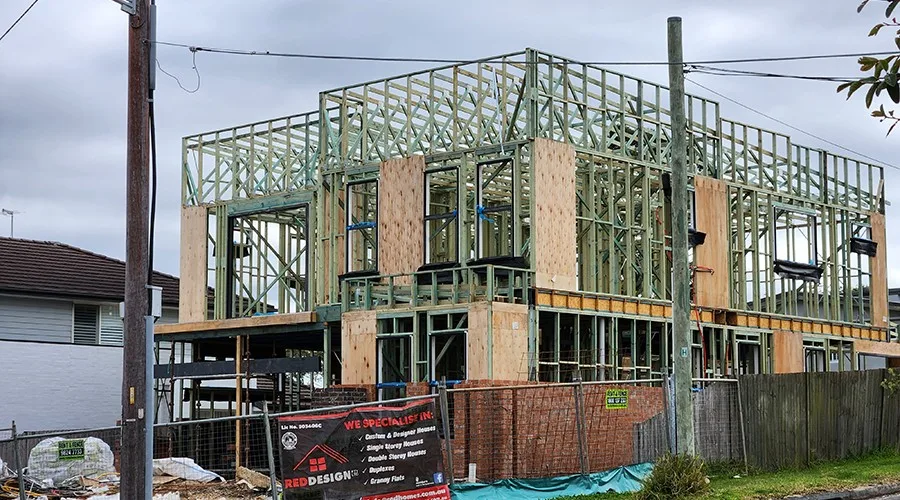
Image: Alex Kidman/Finder
Even at 10x zoom where I'm heading towards a bedroom. It's clearly downscaling via that 50MP sensor, but it's still quite good for detail:
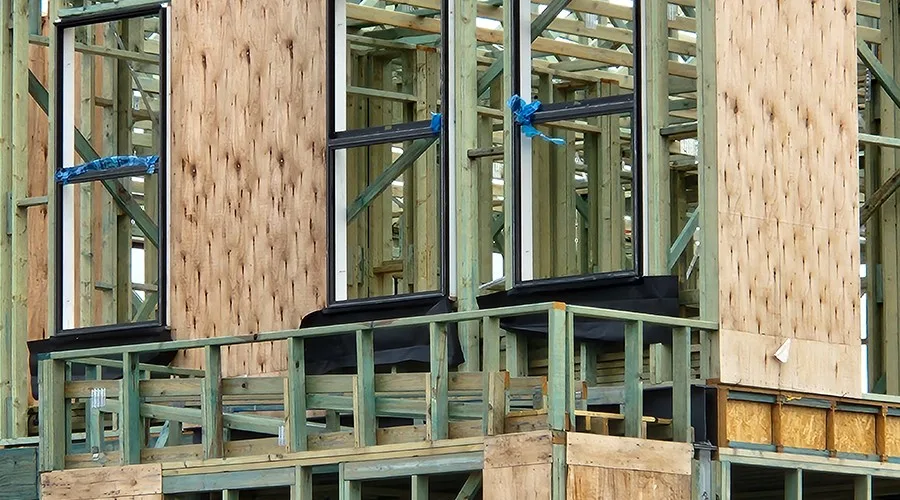
Image: Alex Kidman/Finder
Push it all the way out to 30x zoom, however, and it does predictably fall apart:
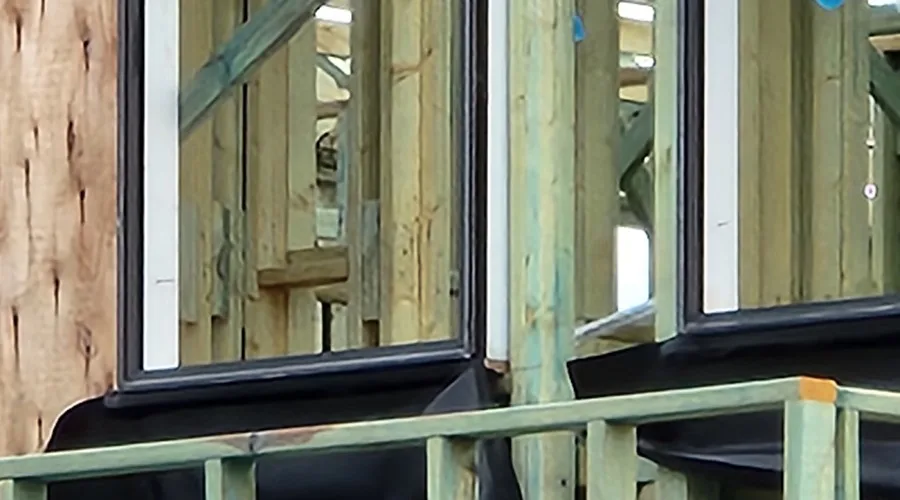
Image: Alex Kidman/Finder
Low-light photography is quite good, again in line with what I saw out of the S22+, with good black detail and contrast. Sydney's not quite the best place to try astrophotography, but if you like a bit of glow in your shots, it can handle itself quite nicely:
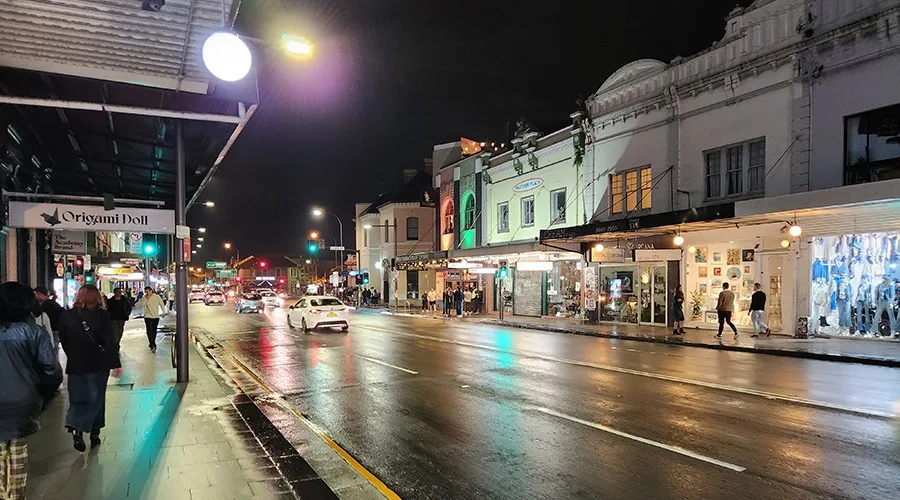
Image: Alex Kidman/Finder
There are still some limitations in play here. That primary 4MP selfie sensor isn't going to be much use for glamour shots, though I could see a use for it when using the full display for video conferencing.
While you can use the rear cameras with the screen unfolded, benefitting from an instant preview of each shot as you take it, it's still an unwieldy way to take photos in most situations.
It's also still a little galling that you'd spend the full premium whack for the Z Fold4 and not get Samsung's best cameras. Maybe next year, Samsung?
Samsung Galaxy Z Fold4 sample photos
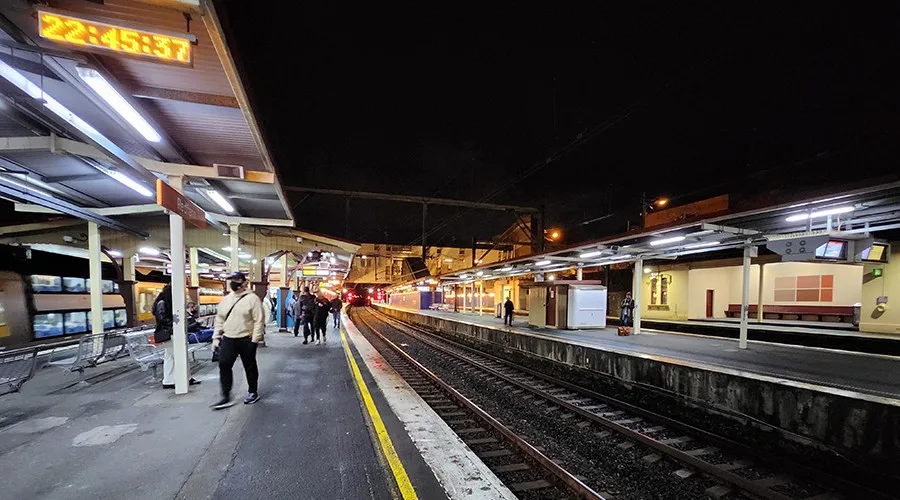
Image: Alex Kidman/Finder
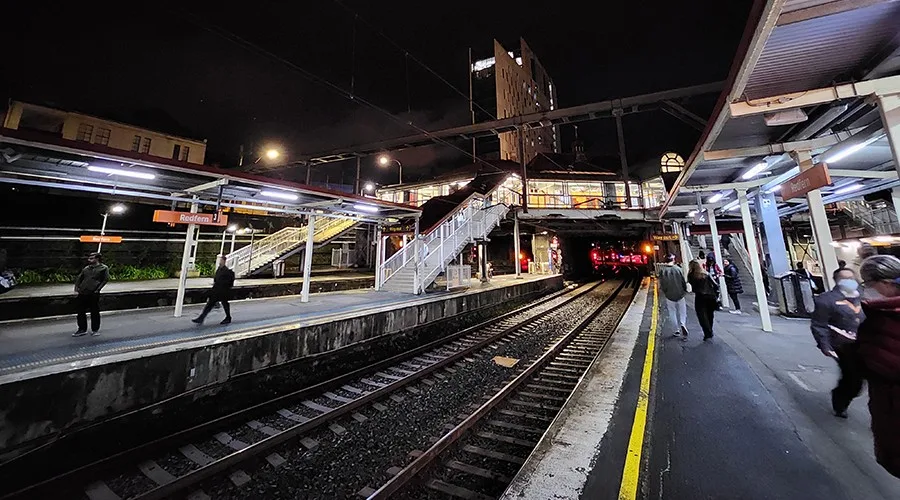
Image: Alex Kidman/Finder

Image: Alex Kidman/Finder

Image: Alex Kidman/Finder

Image: Alex Kidman/Finder
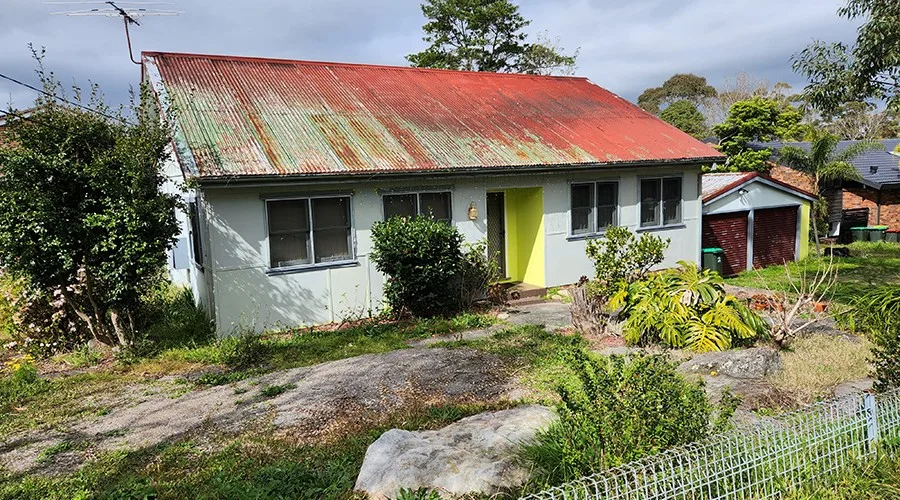
Image: Alex Kidman/Finder
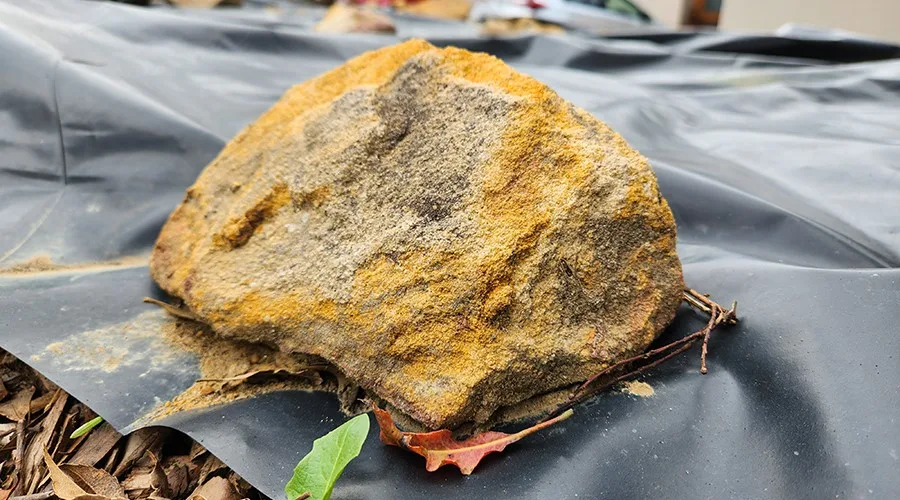
Image: Alex Kidman/Finder

Image: Alex Kidman/Finder

Image: Alex Kidman/Finder
Performance: Are Android tablets finally starting to make sense?
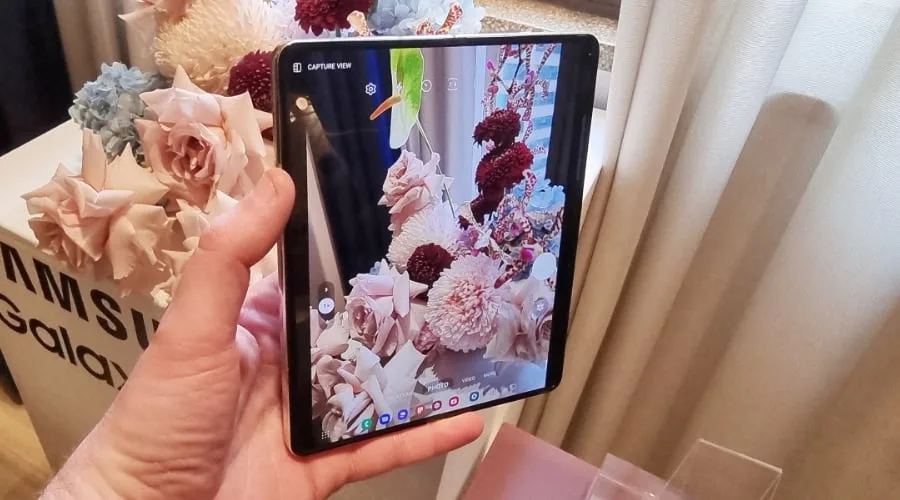
Image: Alex Kidman/Finder
The Galaxy Fold Z4 runs on a Qualcomm Snapdragon Snapdragon 8 Plus Gen 1 processor, aided by 12GB of RAM and either 256GB, 512GB or 1TB of internal storage. Like prior generations, there's no support for microSD expansion cards.
All of that adds up to a phone that's nicely powerful, which is exactly what the Galaxy Z Fold4 needs to be, given its dual status as a smartphone and as a small Android tablet.
Predictably, if you look at it from a benchmark point of view, it's still trailing the best that Apple can offer. Here's how it compares against a range of premium handsets and last year's model using Geekbench 5's CPU test:
Those phones all ship at lower price points than the Galaxy Z Fold4 does, so you wouldn't buy it for that reason alone.
When it comes to GPU power, the Galaxy Z Fold4 was the first phone I've tested to max out 3DMark's standard Wild Life test. That's something that not even the Apple iPhone 13 Pro Max manages.
With that in mind, I tested the phones I could with the more demanding 3DMark Wild Life Extreme test.
So it's a draw between Apple and Samsung here, because the Fold4 bests the iPhone on straight Wild Life, but is bested on the extreme version in return.
What all of that adds up to is a pleasantly powerful phone that can run any Android app you want to throw at it. Again, though, that wouldn't be enough to drop the serious cash that Samsung wants for the Galaxy Z Fold4 by itself.
Where that comes into play is with that primary tablet screen. As with prior generations, you can fling apps from the cover screen to the main screen with relatively few issues as well as run multiple apps in distinct app windows on the primary display quite nicely. The crease is still present, both visually and when you slide your finger across it.
What's new here is a taskbar that is similar to a desktop-OS taskbar. This is new to Android 12L, the operating system that the Galaxy Z Fold4 runs on.
This adds a lot of quick multitasking ability to the Z Fold4 – at the very slight cost of muscle memory. If you're a long-term Android user, you're probably used to a specific space and layout style for the home, back and menu buttons at the bottom of the screen.
Adding the taskbar shifts those buttons slightly to the left, and it's still something I'm struggling to adapt to. It's easier to hit with a thumb if I'm using one hand, but I seem to always go for the wrong spot if I'm holding the Galaxy Z Fold4 with both hands.
The Galaxy Z Fold4 is also S-Pen compatible, although like last year's model, it's not included, and it won't work with every S-Pen you might have from prior Galaxy Note or Galaxy S22 Ultra handsets.
In fact, it won't work with any of them.
The flexible display on the Galaxy Z Fold4 is IPX8 rated, so it's water resistant, but it's not as scratch resistant as a true reinforced glass display would be.
With that in mind, Samsung produces specific S-Pens for use with the Fold devices. The S Pen Fold Edition and S Pen Pro are the compatible models, and there's neither in the box with the Z Fold4.
It would have been nice to include one, and even nicer for Samsung to somehow work out a way for an S-Pen to ride within the Z Fold4's body. Again, maybe next year, Samsung?
Battery: Samsung's getting better at battery life
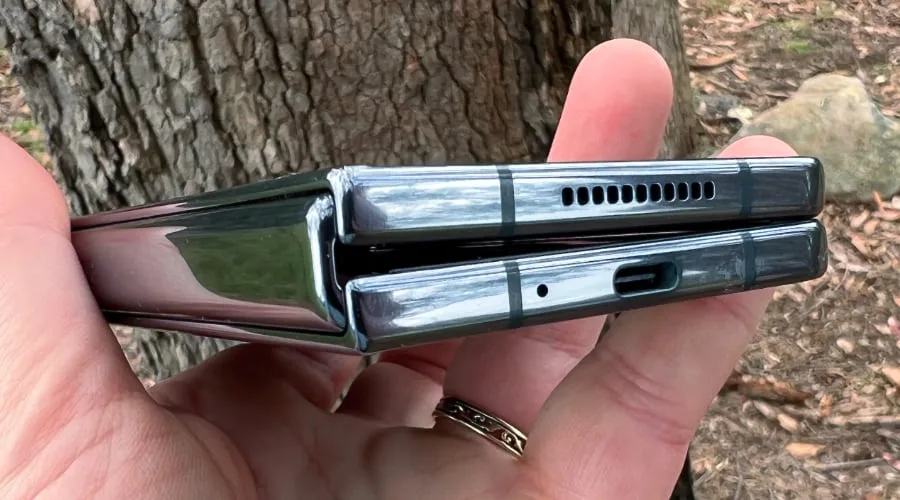
Image: Alex Kidman/Finder
One of the biggest complaints I've had about Samsung phones for the past few generations is that they've not kept pace with general battery life trends in flagship phones.
That used to be Apple's calling card – and it still is if you buy an iPhone SE 2022 – so with the added processing power and enhanced cameras, I was quite worried about how the Galaxy Z Fold4 might fare.
It turns out I need not have worried, at least based on Finder's battery life test. Here's how the Galaxy Z Fold4 compares:
I start to worry any time a phone sits at 90% or less on that test because those are the models that will typically struggle to last through a full day. 92% isn't up there with the best of the best right now, but it's enough power for a day and pleasing when you consider that no other tested phone runs as a dual-screen model with tablet capabilities.
My more anecdotal testing backs this up, too. While I've only had the Galaxy Z Fold4 for a week's testing so far, it's managed most days of usage without running out of power too rapidly.
As always, if you throw enough heavy 5G usage or long-term gaming at it, the Z Fold4 will lose battery capacity much faster.
Charging is supported via USB-C at up to 25W while also supporting 15W wireless charging as well as Samsung's take on reverse wireless charging.
Like so many other premium phones these days, you'll find neither a wired nor wireless charger in the box, so you'll have to budget extra to keep it topped up if you don't already have a spare charger.
Should you buy the Samsung Galaxy Z Fold4?
- Buy it if you want the best foldable phone available right now.
- Don't buy it if you need a more durable phone or Samsung's best cameras.
The Galaxy Z Fold4 really is a case of gentle evolution. It irons out some of the more egregious issues that the Galaxy Z Fold3 had, upping both performance and battery life, which is quite pleasing.
However, it's still a very expensive phone. Or it's a very expensive tablet with phone capabilities. Or it's both, but even if it's both, it's still going to give your credit card a hefty kicking if you want one.
Foldables still aren't as durable as their straight-edge smartphone counterparts, and it would be nice to see Samsung throw its best cameras into the mix too, but that price point is really the biggest sticking point right now.
However, if you don't have an issue with the price, there's no doubt that the Z Fold4 is the best foldable you can buy right now. That's an easy goal to kick when you're basically the sole competitor, of course.
"I've been using the Samsung Galaxy Z Fold 4 for a year now. It was not my daily drive when I first purchased it since I was still using my Samsung Note 20 Ultra and, later, an iPhone 14 Pro Max. At first I was just using it to watch movies on Netflix, but halfway through 2023 I started using it for my travels and I enjoyed it so much. I love how it processes my camera shots, even with too much exposure it will adjust the image automatically. I love that you can have a phone and mini tablet in one gadget. I don't use phone protection on my gadgets, so its lack of protective casing stock whenever I check Samsung's online store is not a problem. So far, it still looks good. Overall, I'll give it a 9 out of 10. I would probably opt in for a Fold 5 if I have the funds."
Pricing and availability
The Galaxy Z Fold4 retails in Australia for $2,499 with 256GB of storage, $2,699 with 512GB of storage or $2,999 with 1TB of storage. It's also available on a variety of telco plans with monthly payment terms.
Compare Samsung Galaxy Z Fold4 plans
Specifications
Display
Camera
Physical Dimensions
Connectivity
Power, storage and battery
Device features
How we tested
The Galaxy Z Fold4 was extensively tested over a week, taking in both benchmark and anecdotal app performance testing, heavy-duty photography and videography across all 5 lenses and battery testing within that time frame. The unit used was loaned to me by Samsung for the purposes of review.
As a phone reviewer, I have more than 2 decades of experience, and I've tested every single premium flagship smartphone in Australia, including all prior generations of Samsung's foldable phone lines. I'm also a multi-time Australian IT Journo award winner, including awards for best reviewer and best technical journalist.
Alex Finder
Senior editor
You are about to post a question on finder.com.au:
- Do not enter personal information (eg. surname, phone number, bank details) as your question will be made public
- finder.com.au is a financial comparison and information service, not a bank or product provider
- We cannot provide you with personal advice or recommendations
- Your answer might already be waiting – check previous questions below to see if yours has already been asked
Finder only provides general advice and factual information, so consider your own circumstances, or seek advice before you decide to act on our content. By submitting a question, you're accepting our Terms Of Service and Finder Group Privacy & Cookies Policy.
This site is protected by reCAPTCHA and the Privacy Policy and Terms of Service apply.

